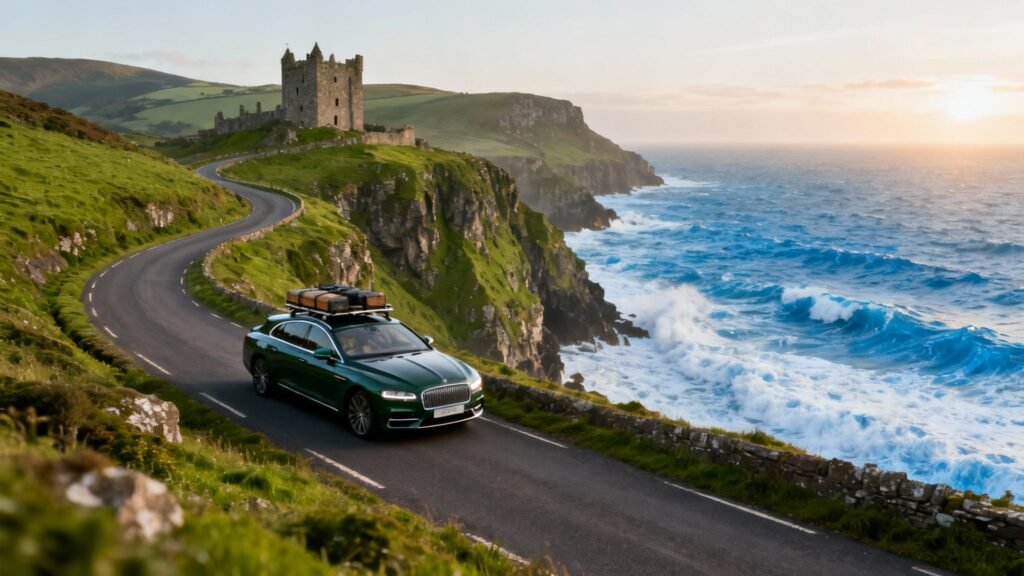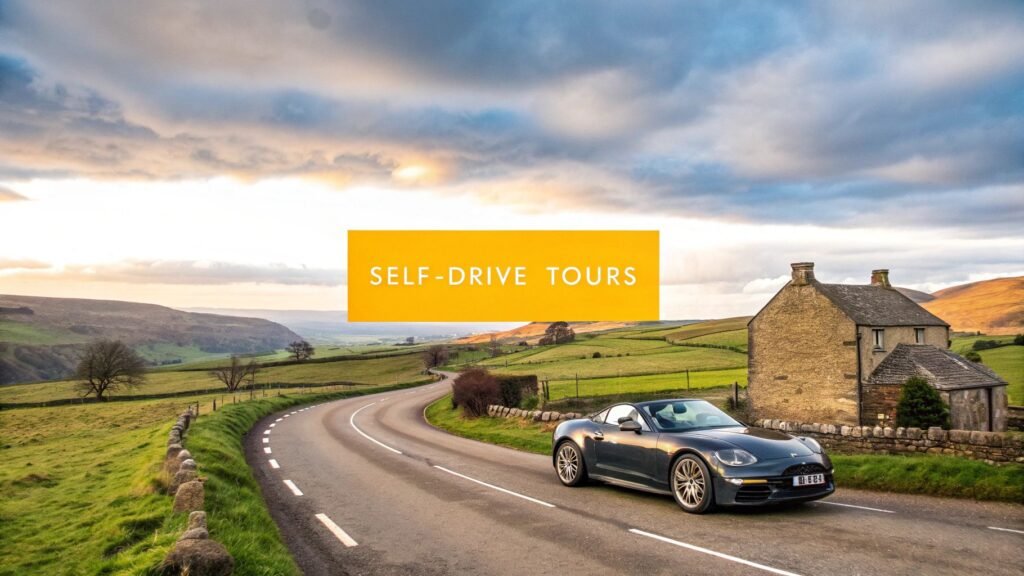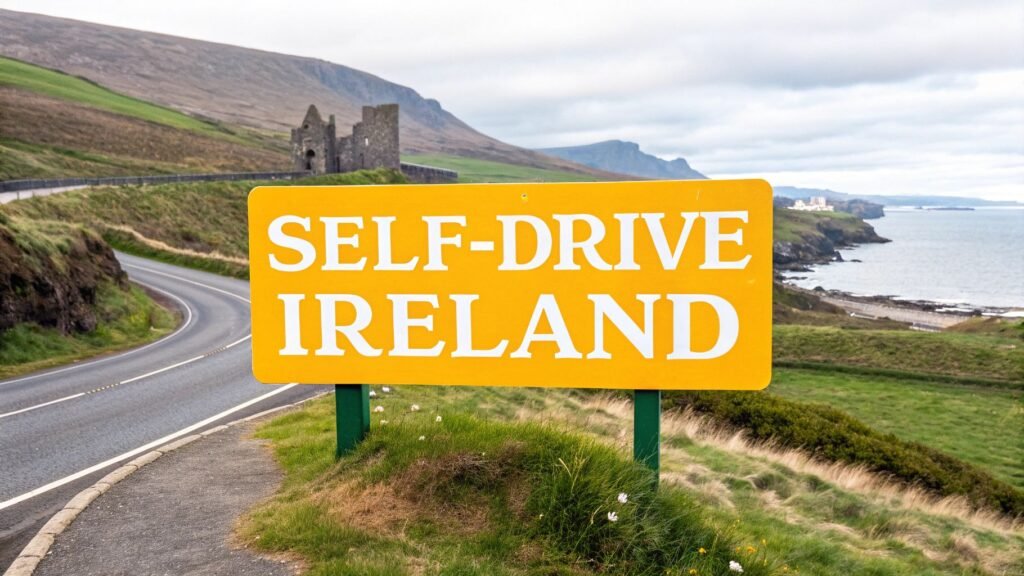There's simply no better way to see Ireland than from behind the wheel of your own car. It gives you the freedom to properly get lost in its famous landscapes and uncover those little hidden gems, all on your own schedule. This is about forgetting rigid itineraries, lingering a little longer at a windswept cliff, or discovering a charming village that isn't on any typical tourist map. It's an adventure driven purely by your own curiosity.
Unlocking Ireland Your Way with a Self-Drive Tour
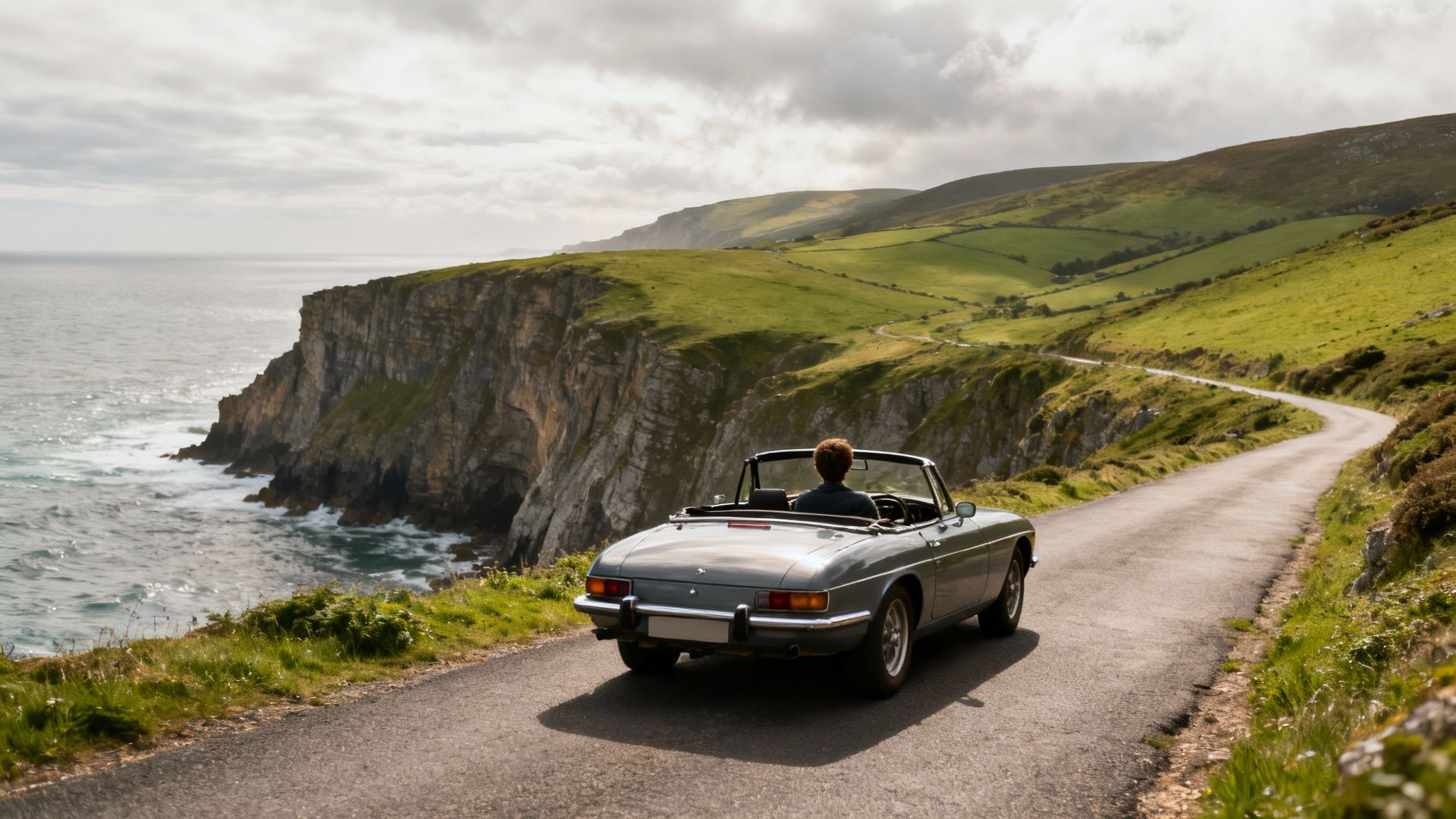
Think of Ireland less as a checklist of sights and more as a story waiting for you to tell. A big bus tour will show you the main characters—the Cliffs of Moher, the Ring of Kerry—but a self-drive tour lets you discover all the fascinating subplots. It’s the difference between watching a film and getting to direct your own.
You get to decide when to pull over for that perfect photo, when to turn down a narrow lane that looks like it leads to a hidden beach, and when to spend an extra hour in a pub just because the traditional music is too good to leave. This is how a simple holiday becomes a true personal exploration, creating those spontaneous moments that just can't be scheduled.
The True Spirit of Irish Exploration
When you tour Ireland by car, you connect with the country on a much deeper level. The journey itself becomes just as memorable as the destinations. Instead of being herded from one busy spot to the next, you’re the one in control, making those in-the-moment decisions that always lead to the most authentic experiences.
This is exactly what makes our https://btours.com/self-drive-tours/ so special; they strike the perfect balance between having a plan and having the freedom to stray from it. Essentially, a self-drive tour gives you:
- Total Flexibility: Fancy another hour over that seaside lunch or want to hike an extra trail? Go for it. There’s no clock to watch.
- Authentic Discovery: You’re free to find the local artisans, quiet ruins, and friendly pubs that lie well off the beaten path.
- A Personal Pace: You can build your days around what you love, whether you're a history buff, a nature lover, or a foodie.
- A Deeper Connection: Experience the real rhythm of Irish life by travelling through its small towns and countryside on your own terms.
A self-drive tour isn't just a way of travelling; it’s a mindset. It's about embracing the unknown and letting chance guide you to the real heart and soul of the Emerald Isle, one winding road at a time.
Why More Travellers Choose the Open Road
The sheer appeal of this independent style of travel is clear when you look at the numbers. In a recent year, Ireland welcomed around 11.3 million overseas visitors, and a huge number of them chose to explore its scenic routes by car. This boom brought an estimated €6.7 billion into the economy and supported roughly 260,000 jobs, cementing the country's reputation as a top-tier travel destination. You can find more details on Ireland's visitor economy statistics on hotelagio.com.
Think of this guide as your co-pilot. We're here to introduce you to the truly iconic routes like the Wild Atlantic Way and the Causeway Coastal Route. We’ll help you craft an unforgettable adventure and show you exactly why touring Ireland is an experience best enjoyed from the driver's seat.
Finding Your Perfect Irish Driving Route
Choosing where to point your bonnet on a self-drive tour of Ireland is a bit like picking the soundtrack to your trip. Each route has its own rhythm, its own distinct character that will shape your entire experience. This isn't just about getting from A to B; it's about the story that unfolds through your windscreen. Will it be a dramatic epic set against raw, wild coastlines, or a quieter tale steeped in 5,000 years of history?
Let's break down Ireland’s most celebrated drives. Think of this as your compass, helping you find the journey that truly speaks to you.
The infographic below perfectly captures the essence of what makes the Wild Atlantic Way so special—that constant, breathtaking dialogue between the land and the untamed ocean.

It’s this very drama that draws so many people to Ireland's magnificent west coast.
To make your decision a little easier, here's a quick side-by-side look at the routes we're about to explore.
Comparing Ireland's Top Touring Routes
| Route Name | Region | Key Highlights | Ideal Duration | Best For |
|---|---|---|---|---|
| Wild Atlantic Way | West Coast (Donegal to Cork) | Cliffs of Moher, Ring of Kerry, Connemara, Slieve League | 10-14 days | Adventure seekers & landscape photographers |
| Causeway Coastal Route | Northern Ireland Coast | Giant's Causeway, Carrick-a-Rede Rope Bridge, Dark Hedges | 2-3 days | Myth lovers & those on a shorter schedule |
| Ireland's Ancient East | East & South-East | Brú na Bóinne, Rock of Cashel, Glendalough, Kilkenny | 5-7 days | History buffs & cultural explorers |
| Ring of Kerry | County Kerry (South-West) | Killarney National Park, Skellig Michael, charming villages | 1-3 days | First-time visitors & classic scenery lovers |
Each route offers a unique slice of Ireland. Now, let's dive into the details to see which one feels like the right fit for your adventure.
The Wild Atlantic Way: A Coastal Epic
Stretching for a mind-boggling 2,500 km along Ireland's entire western seaboard, the Wild Atlantic Way isn't just a road trip; it's an odyssey. This is the longest defined coastal touring route in the world, a masterpiece carved by the sheer force of the Atlantic. It's the Ireland of postcards and dreams—towering cliffs, waves crashing against the shore, and tiny hidden beaches that make you feel like you've found the edge of the world.
This is a route for the adventurer, the photographer, and anyone looking to be humbled by nature. It absolutely demands time and a willingness to embrace the wild. This isn't a journey to be rushed; it’s one to be savoured. For a deeper dive, our detailed guide on the Wild Atlantic Way in Ireland has all the specifics you'll need.
- Key Highlights: The iconic Cliffs of Moher, the world-famous Ring of Kerry, the stark beauty of Connemara, and the colossal sea cliffs of Slieve League.
- Ideal Duration: Give it 10-14 days to truly do it justice without feeling like you're constantly behind the wheel.
- Best For: Travellers hungry for dramatic landscapes, outdoor adventures, and a genuine sense of untamed wilderness.
The Causeway Coastal Route: Myths And Giants
In stark contrast to the sprawling west coast, Northern Ireland's Causeway Coastal Route is a compact, myth-soaked journey of just over 200 km. But don't let its length fool you; what it lacks in distance, it more than makes up for in legendary sights. Winding between Belfast and Derry~Londonderry, the route hugs a coastline packed with geological wonders, ancient castle ruins, and familiar landscapes from film and television.
Think of this drive as a collection of brilliant short stories rather than a single epic novel. Every turn in the road reveals a new chapter, from the otherworldly basalt columns of the Giant's Causeway to the knee-trembling Carrick-a-Rede Rope Bridge.
This is a route where myth and reality truly blur. You'll walk in the footsteps of giants, cross precarious bridges first strung up by fishermen centuries ago, and see landscapes so unique they feel like they belong on another planet. It’s perfect for those with less time but a big imagination.
Ireland's Ancient East: A Journey Through Time
If the west coast is a celebration of nature's power, Ireland's Ancient East is a testament to the power of stories. This touring region covers the area south of Dublin and east of the River Shannon, a landscape brimming with over 5,000 years of history. It’s less of a single, defined road and more of a rich tapestry of historical sites all woven together.
Driving here is like travelling through a living history book. You can step inside prehistoric tombs at Brú na Bóinne that are older than the pyramids, stand in the shadow of medieval fortresses like the Rock of Cashel, and trace the Viking origins of cities like Waterford. The journey here is less about the road itself and more about the destinations and the ancient tales they hold.
- Key Highlights: The Neolithic wonders of Newgrange (Brú na Bóinne), the majestic Rock of Cashel, the serene monastic site of Glendalough, and Kilkenny's Medieval Mile.
- Ideal Duration: A good 5-7 days will allow you to properly delve into the key historical sites.
- Best For: History buffs, cultural explorers, and families looking for an engaging and educational adventure.
The Ring Of Kerry: A Postcard-Perfect Classic
The Ring of Kerry is arguably Ireland's most famous drive for a reason. This 179 km loop around the Iveragh Peninsula is a concentrated dose of everything that makes Ireland so enchanting: rolling green hills, sparkling lakes, a rugged coastline, and villages so charming they almost don't seem real. While it's technically part of the wider Wild Atlantic Way, it absolutely stands on its own as a world-class journey.
It’s often called "Ireland in miniature," offering a stunning variety of landscapes packed into a manageable circuit. It's the perfect introduction for first-time visitors or those on a tighter schedule who want that quintessential Irish scenery without committing to a two-week-long expedition.
How to Plan Your Day-by-Day Road Trip Itinerary
So, you’ve picked a route. That’s the fun part, the spark of inspiration. But now comes the real art: turning that line on a map into a fantastic, day-by-day plan. A well-paced itinerary is what separates a frantic, box-ticking dash from a truly memorable journey. The trick is to strike that perfect balance between seeing the must-see sights and leaving room for the spontaneous magic that makes an Irish road trip so special.
To give you a head start, I've put together three itineraries that I know work brilliantly. Think of them less as rigid schedules and more as flexible starting points. Each one is designed to give you the best of a region without running you ragged, balancing time behind the wheel with time for genuine exploration.
The 7-Day Wild West Coast Adventure
This is a powerful, concentrated shot of the Wild Atlantic Way, zeroing in on its most dramatic southern and central stretches. It’s perfect if you've got a week and you’re after epic coastal views, ancient history, and lively towns.
-
Day 1-2: Killarney and the Ring of Kerry
Arrive and settle into Killarney. Spend your first day getting lost in the gorgeous Killarney National Park—don't miss Muckross House and Ross Castle. On day two, it’s time to tackle the legendary 179 km Ring of Kerry. Give it the whole day; you'll want to stop constantly for photos and a good lunch in a charming village like Portmagee. -
Day 3: The Dingle Peninsula
Today is for the breathtaking Slea Head loop. It’s a shorter drive than the Ring of Kerry but is absolutely packed with ancient beehive huts, staggering cliffs, and the impossibly colourful fishing town of Dingle. -
Day 4-5: The Cliffs of Moher and the Burren
Time to head north into County Clare. Plan to spend an afternoon taking in the sheer scale of the Cliffs of Moher. The next day, wander through the strange, lunar-like landscape of the Burren National Park before ending up in Doolin, the heart of traditional Irish music. -
Day 6-7: Galway and Connemara
Make your way to Galway, a city buzzing with culture and incredible food. It's the perfect base for a day trip into the wild, rugged beauty of Connemara, a land of deep valleys and quiet lakes. From there, you can easily head back towards Dublin or Shannon.
The 5-Day Journey Through Myths and Giants
This is a shorter, punchier trip focusing on Northern Ireland's incredible Causeway Coastal Route, with a bit of ancient history thrown in. It's an ideal choice if you're short on time but want a journey steeped in folklore, geology, and legendary tales.
-
Day 1: Belfast and the Coast
Start in Belfast and soak up its rich history before hitting the road. Drive north along the stunning coast, making a stop for the thrilling Carrick-a-Rede Rope Bridge. Find a place to stay overnight near Ballycastle. -
Day 2: The Giant’s Causeway
Dedicate your morning to the unbelievable Giant's Causeway, a UNESCO World Heritage site that really has to be seen to be believed. In the afternoon, explore the dramatic clifftop ruins of Dunluce Castle and the mysterious Dark Hedges, that famous avenue of beech trees. Many people find that a self-drive tour is the best way to see the various Game of Thrones filming locations in Ireland. -
Day 3: Derry~Londonderry to County Monaghan
Explore the historic walled city of Derry~Londonderry in the morning. Then, it's time to drive south, crossing back into the Republic of Ireland to spend a night in the peaceful lakelands of County Monaghan. -
Day 4-5: Ireland’s Ancient East
Your journey takes you to Brú na Bóinne to tour the prehistoric passage tombs of Newgrange and Knowth—these sites are older than the pyramids. On your final day, visit the haunting monastic ruins of Glendalough in the Wicklow Mountains before finishing your trip in Dublin.
Remember, the best itineraries leave room for the unexpected. If you find a hidden beach or hear about a local festival, don't be afraid to alter your plan. Spontaneity is a key ingredient for a memorable Irish road trip.
The 14-Day Complete Emerald Isle Grand Tour
If you’re lucky enough to have two weeks, this is the one. This grand tour gives you a comprehensive taste of the entire island, combining the highlights of the Wild Atlantic Way, the Causeway Coast, and Ireland’s Ancient East for the ultimate road trip experience.
-
Days 1-3: South-East History
Begin in Dublin, then head south to explore Kilkenny's medieval mile and the iconic Rock of Cashel. -
Days 4-6: Cork and Kerry
Discover Cork's fantastic food scene before hitting the road for the spectacular Ring of Kerry and Slea Head Drive. -
Days 7-9: The Wild West
Experience the awesome power of the Cliffs of Moher, the unique landscape of the Burren, and the cultural buzz of Galway City. -
Days 10-11: Connemara and the North-West
Drive through the untamed landscapes of Connemara and push on up into County Donegal, home to the immense Slieve League cliffs. -
Days 12-14: Northern Ireland and Return
Cross into Northern Ireland to see the Giant’s Causeway and Belfast before making your way back down to Dublin to complete your incredible journey.
Mastering the Roads: A Guide to Driving in Ireland
The idea of driving in Ireland might seem a bit daunting at first, but trust me, it’s the key that unlocks the country's greatest treasures. Getting behind the wheel is part of the adventure, turning a simple holiday into a real exploration. With a little bit of prep, you’ll be handling those winding lanes and roundabouts like a local in no time.
Let's get the big one out of the way: driving on the left. If you’re from a country that drives on the right, it’s going to feel weird for the first hour or so. Your instincts will be screaming at you to hug the wrong side of the road. A good co-pilot or even just a sticky note on the dashboard that says "Stay Left!" can work wonders.
Navigating Irish Roads and Roundabouts
Many of Ireland’s most spectacular views are found down narrow country roads, often hemmed in by ancient stone walls or overgrown hedgerows. We call these little roads 'boreens', and they demand a slower, more careful pace. Don't be surprised if you come face-to-face with a tractor or a flock of sheep—it’s all part of the authentic Irish driving experience!
The unwritten rule on a boreen is simple: pull into a wider spot if you see one, or be ready to reverse to the last passing place you saw. It's a team effort.
Roundabouts are everywhere, especially around towns and cities. They’re brilliant for keeping traffic moving once you get the hang of them.
- Yield on Entry: You must give way to traffic already on the roundabout, which will be coming from your right.
- Signal Your Exit: As you pass the exit before the one you want, flick on your left indicator. This tells drivers waiting to enter what you’re doing.
- Know Your Lane: On larger, multi-lane roundabouts, the general rule is to use the left lane for the first or second exit. If you’re going further around, you’ll want to be in the right lane.
Understanding Road Signs and Speed Limits
Most road signs use standard international symbols, but if you venture into a Gaeltacht (Irish-speaking) area, some signs might only be in Gaelic. Place names often appear in both English and Irish, so it helps to know both for your destination. For example, Dingle is also known as An Daingean.
A crucial point: speed limits are in kilometres per hour (km/h), not miles per hour (mph). Keep a close eye on the signs, as the limits can change quickly.
Remember that the posted speed limit is an absolute maximum, not a target. On a tight, winding country road with blind corners, hitting the limit would be downright dangerous. Always adjust your speed to the conditions.
Before you set off, it’s a good idea to review some essential long-distance driving tips to make sure you're ready for long days of sightseeing. This is especially true in peak season when you'll be sharing the road with more people. Just to give you an idea, in a recent May, Ireland welcomed 560,500 foreign visitors, with 29% arriving from North America, a figure showing strong year-on-year growth.
Choosing and Renting Your Car
Picking the right hire car can make or break your trip. A smaller car is infinitely easier to manage on narrow lanes and will be a lifesaver when you’re trying to park in a tiny village.
Also, and this is important, pay very close attention to the transmission type. Most hire cars in Ireland are manual (stick shift) by default. If you aren't comfortable driving a manual, you must book an automatic well in advance. They’re less common and more expensive, and trying to learn to use a clutch while also learning to drive on the left is a recipe for a very stressful holiday.
Finally, get your head around the insurance options. Most rentals include a basic Collision Damage Waiver (CDW), but this usually comes with a hefty excess fee if you have an accident. For complete peace of mind, it’s often worth purchasing extra cover, either from the rental company itself or through your credit card.
Where to Stay and What to Experience Along the Way
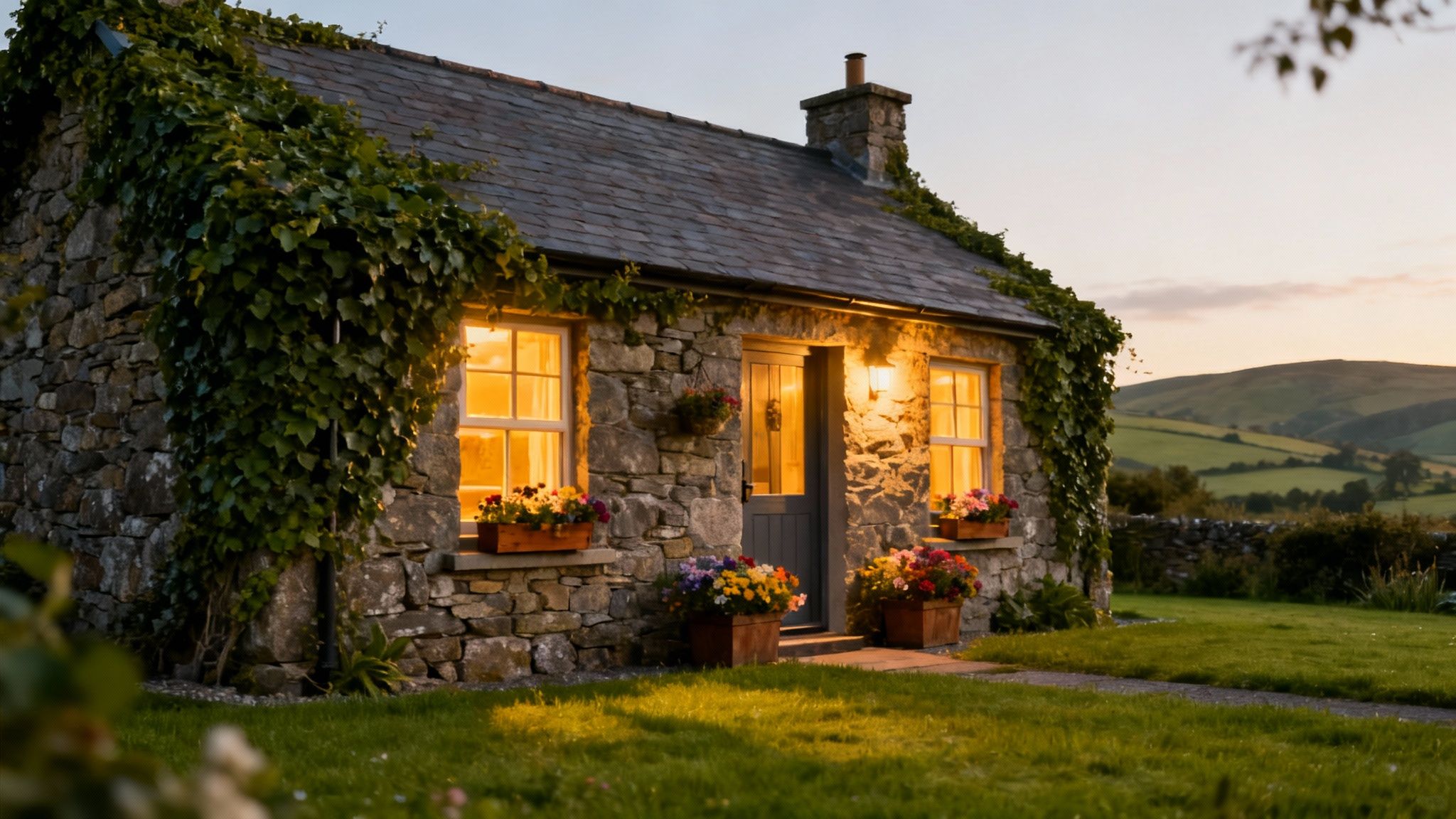
A truly unforgettable Irish road trip isn’t just about what you see through the windscreen. The real magic happens when you turn off the engine—to sleep in a place with soul, to taste food pulled straight from the local land and sea, and to lose yourself in the rhythm of a proper trad music session.
These are the moments that give your journey its heart, turning a scenic drive into a genuine connection with the island. It’s about more than just finding a bed for the night; it’s about choosing a place that becomes part of your story.
Finding Your Authentic Irish Accommodation
The places you choose to stay will colour your entire trip. While you’ll find modern hotels everywhere, I always recommend seeking out more traditional stays. They offer a window into Irish life that you simply can’t get from a standard hotel room.
- Family-Run B&Bs: This is the heart of Irish hospitality. Expect a welcome as warm as the tea, a cosy room, and a “full Irish” breakfast that will set you up for a day of exploring. Your hosts are often a goldmine of local knowledge, eager to point you towards hidden gems the guidebooks miss.
- Historic Castle Hotels: Fancy a touch of grandeur and romance? Nothing beats spending a night as lord or lady of the manor. Many of Ireland’s stunning castles have been transformed into luxurious hotels, beautifully blending centuries of history with modern comforts.
- Quaint Guesthouses: Often found tucked away in charming towns, guesthouses are the perfect middle ground. They typically offer more space and amenities than a B&B but still feel personal and intimate in a way larger hotels rarely do.
Choosing where to stay is really about deciding what kind of experience you’re after. A B&B connects you to the local people, while a castle connects you to the country’s epic history.
Immersing Yourself in Irish Culture
Beyond the incredible landscapes, the true spirit of Ireland is found in its vibrant, living culture. Actively seeking out these experiences will enrich your tour in ways you can’t imagine. It’s about joining in, not just looking on from the sidelines.
A fantastic place to start is with the food. Modern Irish cuisine has undergone a quiet revolution, with a fierce focus on incredible local ingredients. To get a real taste for it, you could even plan your trip around its gastronomy. For a bit of inspiration, check out this dedicated self-drive culinary tour of Ireland to see how food can become the star of your adventure.
Don't Miss These Cultural Highlights
To make your trip truly one for the books, try to weave these authentic experiences into your itinerary. These are the memories that will stick with you long after you’ve returned home.
-
Attend a Trad Session: The lifeblood of Irish culture is its music. Find a local pub in a town like Doolin or Dingle, grab a pint, and settle in as local musicians gather for an informal, foot-stomping session. The atmosphere is always welcoming.
-
Explore Ancient History: Connect with Ireland’s deep past by standing on its most sacred ground. There’s a powerful feeling that comes from being inside the 5,200-year-old passage tomb at Newgrange or gazing up at the majestic Rock of Cashel. You can almost feel the island’s long and storied history around you.
-
Savour Local Flavours: Go beyond the pub stew! Seek out restaurants serving seafood so fresh it was in the sea that morning, visit a local farmer’s market for artisanal cheese, or tour a whiskey distillery to taste the famed uisce beatha (water of life). This is where you’ll find the real taste of Ireland.
Ultimately, the best advice I can give is to stay curious. Chat with the locals, ask for recommendations, and don't be afraid to take that intriguing detour. It’s those spontaneous moments that elevate a good holiday into an exceptional one.
Your Ireland Touring Questions Answered
Putting the final touches on an Ireland trip can feel a bit like herding sheep – a lot of moving parts to get in order! To help you nail down those last few details, I've pulled together answers to the most common questions that come up before a self-drive adventure.
Think of this as a quick chat over a cuppa, where we cover the practical bits and bobs that make the difference between a good trip and a great one. From when to visit to what to pack, let's get you ready for the road.
When Is the Best Time of Year to Visit?
While the summer months of June to August boast the longest days and warmest weather, they also bring the biggest crowds and highest prices. For my money, the sweet spot is in the “shoulder seasons” of spring (April-May) and autumn (September-October).
You’ll find famous sites are much quieter, accommodation is easier on the wallet, and the scenery is just spectacular. Spring is all about blooming wildflowers and newborn lambs dotting the hillsides, while autumn paints the landscape in incredible shades of gold and red. The weather is still generally lovely, though you should always be ready for a classic Irish surprise!
How Should I Budget for a Road Trip?
Every trip is different, of course, but there are a few key costs you'll want to map out for your tour of Ireland.
- Car Hire: This will be one of your main expenses. It’s absolutely vital to book well in advance, especially if you need an automatic. As you weigh your options, you might find it interesting to see how electric vehicles are changing the car rental industry and decide if an EV could work for your route.
- Fuel: Petrol and diesel prices can be a bit of a shock, particularly in more remote areas. Opting for a smaller, more fuel-efficient car can genuinely save you a bundle over a long journey.
- Accommodation: You can’t beat B&Bs and guesthouses for value. They give you a real taste of Irish hospitality and almost always include a massive breakfast that will easily keep you going until lunchtime.
- Food: Pub lunches are your best friend for a delicious, affordable meal. For dinner, keep an eye out for "early bird" menus in towns and villages – they’re a great way to eat well without breaking the bank.
As a rough guide, I'd suggest budgeting around €80-€120 per person per day for your food, fuel, and small entry fees. This doesn't include your car hire or accommodation, but it allows for a comfortable, stress-free trip.
What Should I Pack for Irish Weather?
You’ve probably heard the old saying that Ireland can have four seasons in one day. Well, it’s completely true. The secret to staying happy and comfortable is simple: layers.
Here’s what should be on your non-negotiable packing list:
- A waterproof and windproof jacket: Don't even think about leaving this at home, not even in July. A sudden shower can appear out of a perfectly blue sky.
- Multiple light layers: Think fleece jumpers, long-sleeved tops, and t-shirts. You'll be adding and removing them all day as the sun comes and goes.
- Comfortable, waterproof footwear: You’ll be walking on everything from ancient castle stones to boggy coastal paths. Good, broken-in waterproof shoes are essential.
- A warm hat and gloves: A lifesaver on a windy coastal walk or for anyone visiting outside of high summer.
Do I Need to Book Everything in Advance?
For the big-ticket items, yes, absolutely. You should always book your rental car and your first and last nights' accommodation far in advance, especially if you're travelling in peak season. Certain must-see attractions, like the boat trip to Skellig Michael or the tour of Newgrange, also sell out weeks or even months ahead of time.
That being said, outside of July and August, you can be a bit more spontaneous with your B&Bs along the way. This gives you the wonderful freedom to stay an extra day somewhere you’ve fallen in love with or to change your route on a whim. Just remember that the Irish love to travel, too! In one recent year, residents of the Republic took 11.5 million trips abroad, so you'll be sharing the holiday spirit. You can read more about Irish travel trends on visitbritain.org.
Ready to stop planning and start driving? At BTOURS, we take the guesswork out of your adventure. Our expertly curated self-drive tours provide the perfect route, hand-picked accommodations, and all the support you need, leaving you free to simply enjoy the journey.

